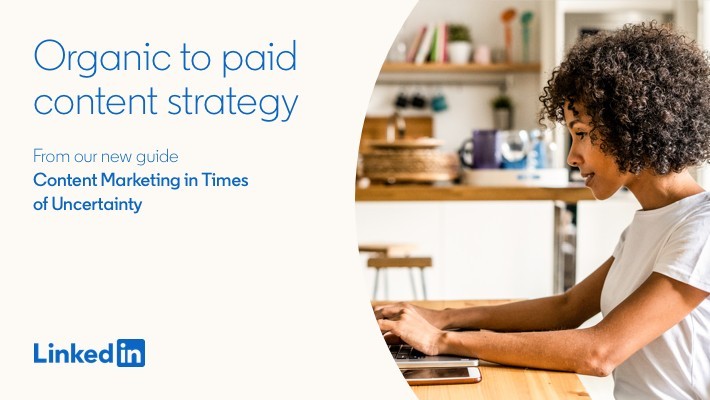What’s the most cost-effective way of getting more eyes on your content?
Content marketing is all about getting the right content in front of prospects at different stages of your funnel. And you need to ensure you’re doing this in a way that brings the most value, in the most relevant format for your audience.
Organic marketing tactics are generally seen as the most effective ways of meeting that balance of value and relevance. However, there are limitations.
Apart from the quality of your output, organic value is driven by regular engagement and a long-term view of ROI.
According to Binet and Field’s 5 Principles of Growth in B2B Marketing, when you’re focusing on long-term growth, you need to grow your share of voice. But any change in market conditions (no, I didn’t mention the pandemic) can mean you need to change your messaging, and potentially even your audience.
When you’ve spent a long time building organic relationships with one objective in mind, it’s not necessarily easy to simply repurpose them. You certainly can’t do it overnight without risking alienating a fairly large chunk of your audience.
You can broaden awareness of new messaging through digital PR tactics like guest blogging or getting coverage in earned media – and in fact, you absolutely should be doing those things. But these tactics are fairly labour-intensive and cannot guarantee that your new content will reach the right people at the right time.
This is where social advertising can add real value to your content marketing strategy. No one’s suggesting it should replace your organic activity, but a well-timed, well-targeted paid campaign can be the catalyst that drives stronger engagement across every part of your funnel.
With the right planning, a paid social campaign can:
- Increase awareness, credibility and impact of your content through the power of social proof
- Engage your ideal target audience, whether composed of influencers, decision-makers or executives
- Drive traffic and leads to your site when the time is right
It might sound counter-intuitive but putting a little bit of budget behind social advertising can even be more cost effective than a purely organic approach.
Try totting-up the cost-per-hour in terms of the time your team spends on blogger or media outreach, social media engagement and all the other necessities of a quality organic strategy. Sometimes all it takes is a little boost to generate better ROI across the board.
A strong organic presence builds loyalty, highlights your brand personality and delivers a consistent level of engagement with your messaging. With social advertising, you can maximise the value you have already built by guaranteeing it will be seen by more people who value the same things.
Nevertheless, the principles of good content do not change. That value/relevance equation still matters. And that means making sure you’ve got the right content, in the right format, for the right audience.
Paid tactics that make a difference to content marketing
The biggest strength of a paid campaign is your ability to combine mass reach with very precise targeting. On LinkedIn, you can define your audience by the company they work for, their work experience, groups, interests, location, industry, job function, seniority and plenty of other options.
However, there’s always a trade-off between targeting and audience size. If your targeting criteria is too narrow, your content may reach a very small audience. Binet and Field say that to grow your share of voice, you need to keep both your messaging and audience broad. As a guide, the most successful LinkedIn campaigns have an audience range between 60K - 400K.
Once you know exactly who you’re targeting, you can be much clearer about the content they will value. Depending on your audience variables, this could be anything from a video to a white paper, how-to guide or case study. And as we’ve already pointed out, your content choice also depends on which part of your funnel you’re targeting.
Now, your method of delivery depends on your objective, audience and type of content. To help you out, here’s a quick break down of the most effective paid options for content marketers on LinkedIn.
Sponsored Content
Sponsored Content allows you to publish relevant content and reach a targeted audience of professionals beyond just your LinkedIn Page followers. Direct Sponsored Content is a feature which allows you to share content directly in your feed, giving you the ability to AB test. You can also make your content more relevant by sending personalised messages to specific audiences. Then test and retest a variety of content in real-time to optimise performance.
This option is great for sharing:
- Links to your latest and greatest whitepapers
- eBooks
- Case studies
- Industry articles
- Helpful how-to content
- Bright visual video content
Sponsored Messaging
These come in two ad formats: The first is a Message Ad, which delivers a targeted message with a single call-to-action. Alternatively, a Conversation Ad offers a choose-your-own-path experience to prospects, including multiple messages and calls to action that depend on how they engage. The advantage here is they offer a greater level of personalisation, with messages that speak directly to your audience’s interests.
They are ideal for:
- Boosting conversions with targeted product and service promotions
- Promoting content your audience wants to see, such as infographics, whitepapers, and reports
- Personalising invitations to webinars and other virtual events
Dynamic Ads
Message relevancy is critical and dynamic ads make it possible to accurately target decision-makers and deal influencers with highly relevant, dynamically generated, customisable creative.
They allow you to promote anything from a piece of content to an event or a landing page, allowing you to automate individualised campaigns at scale.
Text Ads
These intuitive, self-service pay per click ads are only able to appear on desktop, but are a super-fast way to create, manage and optimise a customised campaign. They contain a headline, brief text and an image, making them suited to:
- eBook launches
- Product one-sheeters
- Webinar and virtual event invitations
- Programme demos and certification enrolment
- Infographics
- Blog subscription campaigns
Matched Audiences
Matched Audiences provide three targeting tools to connect with your audiences on LinkedIn, giving you the ability to combine LinkedIn’s user-insights with your own customer data:
- Retargeting: Create target audiences from your website visitors to nurture them with always-on campaigns.
- Account targeting: This lets you support your account-based marketing programs by reaching decision-makers at your target accounts.
- Contact targeting: Engage prospects and contacts on LinkedIn through integration with Marketo, Oracle Eloqua or LiveRamp platforms.
Strike the right balance
Of course, there are plenty of other paid options both on LinkedIn and elsewhere. But the key to using any of them as part of a content marketing strategy is balance. Your paid campaigns should complement your organic strategy rather than overpower it, just as the value of your content should be equal or greater than the level of interruption you employ to put it in front of your prospects.
For more ideas about how to achieve a more effective content marketing strategy in times of uncertainty, download our eBook today.
Related articles



